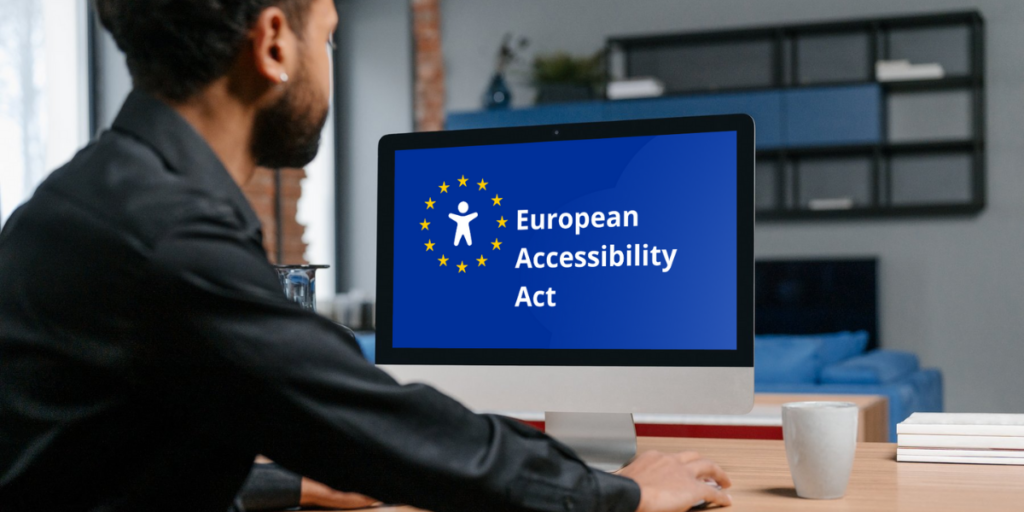The European Accessibility Act (EAA), first adopted in 2019, is a directive aimed at enhancing accessibility across the European Union (EU). With the compliance deadline of June 28, 2025, fast approaching, it’s crucial for businesses and service providers to understand and prepare for the upcoming requirements. Here’s everything you need to know.

What is the European Accessibility Act?
The EAA is designed to make accessibility standards consistent and more robust within the EU, ensuring that all products and services are accessible to individuals with disabilities and the elderly. By establishing a unified set of rules across the region, the Act aims to eliminate barriers arising from varying national regulations, thereby facilitating smoother cross-border trade and promoting inclusivity.
Definition of Disability Under the European Accessibility Act
The EAA defines “persons with disabilities” as individuals who have long-term physical, mental, intellectual, or sensory impairments. These impairments, in interaction with various barriers, may hinder their full and effective participation in society on an equal basis with others.
This definition also aligns with the United Nations Convention on the Rights of Persons with Disabilities, emphasizing a broad and inclusive understanding of disability.
Who Needs to Comply to the EAA?
The European Accessibility Act covers a wide range of products and services identified as most important for persons with disabilities, and most likely to have diverging accessibility requirements across EU countries. These include:
- Information and Communication Technology (ICT) Products:
- Computers and operating systems
- Smartphones
- E-books
- TV equipment related to digital television services
- Telephony services and related equipment.
- Public Services:
- Automated Teller Machines (ATMs)
- Ticketing and check-in machines
- Public transport services (air, bus, rail, and waterborne passenger transport)
- Banking services
- E-commerce platforms.
These areas have been identified as critical for ensuring equal participation in society for individuals with disabilities.
Essential Compliance Steps
To make sure your business is ready for the EAA by the June 2025 deadline, you’ll need to carry out an accessibility audit to evaluate your digital platform—websites, products, and mobile applications—against the Web Content Accessibility Guidelines (WCAG) 2.2 AA standards to identify and prioritize fixing accessibility issues.
This includes making digital content, such as videos and multimedia presentations, accessible to all users. One effective way to achieve this is by implementing language accessibility technologies, such as closed captioning and subtitling.
Role of Language Accessibility in Compliance
It’s important to note that language accessibility technology like closed captioning and subtitling play a crucial role in meeting the EAA’s requirements. These technologies provide text alternatives for audio content, making information accessible to individuals who are deaf or hard of hearing, as well as those who prefer reading over listening. Moreover, they benefit non-native speakers and individuals in noisy environments.
Closed Captioning and Subtitling Requirements
The EAA specifies that audiovisual and multimedia content must be accessible to all users, regardless of their abilities. For instance, broadcasters are expected to provide captions for television programs, and online communication or streaming platforms must ensure that videos are accessible to users with disabilities.
What Happens if You Don’t Comply?
Non-compliance with the European Accessibility Act (EAA) is going to be serious business. It can lead to significant penalties, which vary across EU member states. These penalties are designed to be “effective, proportionate, and dissuasive,” and can include substantial fines, legal actions, and other enforcement measures. For instance, fines can range from €5,000 to €20,000 per violation, depending on the severity of the issue.
In some countries, penalties can be even more severe; for example, in France, fines can reach up to €250,000 for failing to make public-facing platforms accessible.
Beyond financial repercussions, businesses may also face reputational damage, legal proceedings, and exclusion from procurement processes. So, it’s imperative for organizations to proactively ensure compliance with the EAA to avoid risks.

Solutions for EAA Compliance
To comply with the European Accessibility Act, businesses can leverage various solutions:
- Customizable font sizes and styles: Allow users to adjust text size and style to accommodate visual impairments.
- High contrast modes: Provide options for high contrast themes to assist users with low vision.
- Screen reader compatibility: Ensure that all digital content is compatible with screen readers, enabling users with visual impairments to access information.
- Keyboard navigation: Design interfaces that are fully navigable using a keyboard, benefiting users with motor disabilities.
- Voice control integration: Incorporate voice command functionalities to assist users with limited mobility.
- Closed captioning and subtitles: Provide text alternatives for audio content to support users who are deaf or hard of hearing, or who speak another language to the one offered by your business. KUDO offers an all-in-one solution via AI speech translation and captions in 50+ languages that can be implemented on any platform or device in-person or online.
- Alternative text for images: Include descriptive alt text for images to assist users relying on screen readers.
- Adjustable screen brightness and contrast: Allow users to modify screen settings to suit their visual preferences.
- Error identification and suggestions: Implement clear error messages and suggestions to aid users with cognitive impairments.
- Accessible forms: Design forms with proper labeling and error handling to ensure usability for all users.
Key Takeaways
All in all, the European Accessibility Act represents a pivotal move towards a more inclusive digital environment within the EU. With the June 2025 compliance deadline on the horizon, it’s imperative for businesses to take proactive steps to ensure their products and services meet the required accessibility standards.
By doing so, you not only avoid potential legal penalties, but also enhance your brand’s reputation and market reach. Accessible products and services inevitably cater to a wider audience, including individuals with disabilities and the elderly, thereby promoting inclusivity and potentially increasing customer loyalty.
Get in touch with our team to see a demo of our award-winning language accessibility solutions to prepare your organization for the EAA.